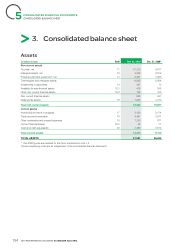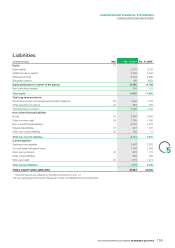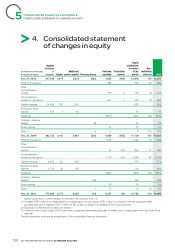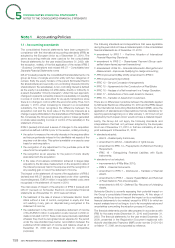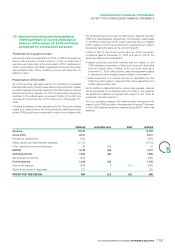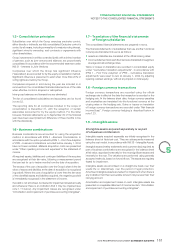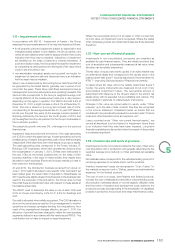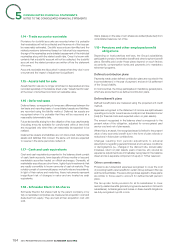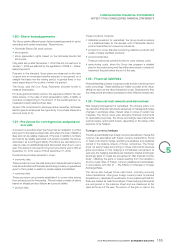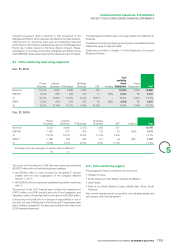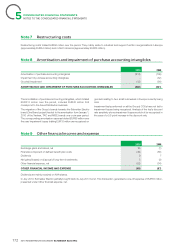APC 2010 Annual Report Download - page 165
Download and view the complete annual report
Please find page 165 of the 2010 APC annual report below. You can navigate through the pages in the report by either clicking on the pages listed below, or by using the keyword search tool below to find specific information within the annual report.
CONSOLIDATED FINANCIAL STATEMENTS
5
NOTES TO THE CONSOLIDATED FINANCIAL STATEMENTS
1.11 - Impairment of assets
In accordance with IAS36 – Impairment of Assets – the Group
assesses the recoverable amount of its long-lived assets as follows:
•for all property, plant and equipment subject to depreciation and
intangible assets subject to amortisation, the Group carries out a
review at each balance sheet date to assess whether there is any
indication that they may be impaired. Indications of impairment
are identifi ed on the basis of external or internal information. If
such an indication exists, the Group tests the asset for impairment
by comparing its carrying amount to the higher of fair value minus
costs to sell and value in use;
•non-amortisable intangible assets and goodwill are tested for
impairment at least annually and whenever there is an indication
that the asset may be impaired.
Value in use is determined by discounting future cash fl ows that will
be generated by the tested assets, generally over a period of not
more than fi ve years. These future cash fl ows are based on Group
management’s economic assumptions and operating forecasts. The
discount rate corresponds to the Group’s weighted average cost
of capital (WACC) at the measurement date plus a risk premium
depending on the region in question. The WACC stood at 8.4% at
December31, 2010, a slight increase on the 8.1% at December31,
2009. This rate is based on (i) a long-term interest rate of 3.8%,
corresponding to the average interest rate for 10year OAT treasury
bonds over the past few years, (ii) the average premium applied to
fi nancing obtained by the Group in the fourth quarter of 2010, and
(iii) the weighted country risk premium for the Group’s businesses in
the countries in question.
The perpetuity growth rate was 2%, unchanged on the previous
fi nancial year.
Impairment tests are performed at the level of the cash-generating
unit (CGU) to which the asset belongs. A cash-generating unit is the
smallest group of assets that generates cash infl ows that are largely
independent of the cash fl ows from other assets or groups of assets.
The cash-generating units correspond to the Power, Industry, IT,
Buildings, CST businesses, which have operated as divisions since
the reorganisation on January1, 2010. Entities were reallocated to
the new CGUs at the lowest possible level on the basis of their
business activities; in the case of mixed entities, their assets were
allocated to each business (Power and Industry mainly) pro-rata to
their revenue in that business.
At end-2010, the Distribution business acquired from Areva on
June7, 2010 wasn’t allocated to any specifi c CGU and hadn’t yet
been tested given the recent date of acquisition. Nevertheless, as
2010 results were slightly ahead of the forecasts in the business plan
used for the purposes of the acquisition, the Group does not feel
there that there are impairment risks with respect to these assets at
the balance sheet date.
The WACC used to determine the value in use of each CGU was
9.0% for Power and Industry, 9.2% for IT, 8.6% for Buildings and
CST.
Goodwill is allocated when initially recognised. The CGU allocation is
done on the same basis as used by Group management to monitor
operations and assess synergies deriving from acquisitions. As a
result of the organisational changes effective January1, 2010, the
allocation of goodwill has been changed to refl ect the new operating
segments defi ned in accordance with the newly issued IFRS8. This
modifi cation did not have an impact on asset impairment.
Where the recoverable amount of an asset or CGU is lower than
its book value, an impairment loss is recognised. Where the tested
CGU comprises goodwill, any impairment losses are fi rstly deducted
therefrom.
1.12 - Non-current financial assets
Investments in non-consolidated companies are classified as
available-for-sale fi nancial assets. They are initially recorded their
cost of acquisition and subsequently measured at fair value, when
fair value can be reliably determined.
The fair value of equity instruments quoted in an active market may
be determined reliably and corresponds to the quoted price on the
balance sheet date (Level 1 input as described in the amendment to
IFRS7 – Improving Disclosures about Financial Instruments).
In cases where fair value cannot be reliably determined (Level 3
inputs), the equity instruments are measured at net cost of any
accumulated impairment losses. The recoverable amount is
determined with reference to the Group’s share in the entity’s net
assets along with its expected future profi tability and outlook. This
rule is applied in particular to unlisted equity instruments.
Changes in fair value are accumulated in equity under “Other
reserves” up to the date of sale, at which time they are recognised
in the income statement. Unrealised losses on assets that are
considered to be permanently impaired are recorded under “Finance
costs and other fi nancial income and expense, net”.
Loans, recorded under “Other non-current fi nancial assets”, are
carried at amortised cost and tested for impairment where there
is an indication that they may have been impaired. Long-term
fi nancial receivables are discounted when the impact of discounting
is considered signifi cant.
1.13 - Inventories and work in process
Inventories and work in process are stated at the lower of their entry
cost (acquisition cost or production cost generally determined by the
weighted average price method) or of their estimated net realisable
value.
Net realisable value corresponds to the estimated selling price net of
remaining expenses to complete and/or sell the products.
Inventory impairment losses are recognised in “Cost of sales” for
the material component and in “Selling, general and administrative
expenses” for the fi nished products.
The cost of work in process, semi-fi nished and fi nished products,
includes the cost of materials and direct labor, subcontracting costs,
all production overheads based on normal capacity utilisation rates
and the portion of research and development costs related to the
production process (corresponding to the amortisation of capitalised
projects in production and product and range maintenance costs).
2010 REGISTRATION DOCUMENT SCHNEIDER ELECTRIC 163



